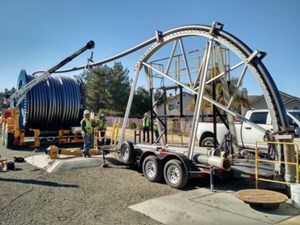PG&E gains ground on undergrounding 10,000 miles of power lines
(UI) — The largest project in the country to bury electricity lines underground is being carried out by Pacific Gas and Electric Company, and it is on target to finish this year, according to KCRA 3 News.
The utility intends to bury 10,000 miles of lines, and work on this project is progressing mile by mile and county by county.
In 2021, PG&E successfully buried 73 miles of power lines, and this year, they are aiming to underground 350 miles of lines. Looking ahead to 2026, their plan is to bury a total of 750 miles, resulting in 2,300 miles underground by the end of that year.
During the burial process, the lines are pulled through a protective layer. While it is true that repairing underground lines can be more challenging than those above ground, PG&E is implementing large boxes to cover spliced areas, facilitating access for maintenance. These boxes are placed approximately 800 to 1,200 feet apart.
Patti Poppe, CEO of the utility, visited a job site on Gordon Valley Road in northern Solano County on Monday. It is a windy location, and locals have long been concerned that a tree blown onto PG&E machinery may spark a wildfire.
As the equipment goes underground, Poppe said that these neighbors will experience a 99% reduction in fire threats. Additionally, they will gain an advantage during windy conditions, as they will no longer be affected by the disruptions caused by Public Safety Power Shutoffs.
"When we first started talking about undergrounding at PG&E, we were thinking about wildfire safety," Poppe told KCRA 3 News. "But what we've realized is it also eliminates the need for public safety power shutoffs for customers, it eliminates the need for interruptions. And then when the snow and the atmospheric rivers come, it's resilient to those conditions as well."
With the aid of evolving information and technology, PG&E has been able to raise its annual targets for this job as the workers become quicker and more experienced.
One example is the burial depth of the lines.
San Diego Gas and Electric conducted studies and discovered that lines can be effectively buried at a depth of 30 inches, deviating from the traditional standard of 36 inches. This adjustment not only saves time but also amounts to a substantial cost-saving of $25 million for PG&E in this year alone.
Crews often work in narrow and rural areas, encountering varying conditions mile by mile. The challenges they face include factors like soil density and terrain angles, making each location unique in terms of the work required for undergrounding power lines.
The process of undergrounding power lines can be disruptive, and each crew comprises a specialized team that prioritizes managing traffic and ensuring access to essential places like homes, workplaces, and schools.
For years, utility companies maintained that burying power lines underground was excessively costly and impractical.
However, following a series of deadly and devastating wildfires sparked by PG&E's equipment, Poppe recognized that the old approach was unsustainable. Embracing the change, she also discovered that certain aspects of the work would lead to significant long-term cost reductions.
According to KCRA 3 News, PG&E's CEO, Poppe, stated, "First of all, we're finding it's too expensive not to underground. We know that undergrounding is lower cost to maintain, lower cost to inspect, lower cost to manage the vegetation around it in the right areas. It is the lowest-cost climate resilient infrastructure."
Currently, the project entails considerable expenses.
Initially, the cost was $4 million per mile. However, with the increase in efficiency and proficiency of the crews, the expenses have decreased, now standing at around $3.3 million per mile. Moreover, PG&E foresees further cost reductions through the implementation of new innovations.
To fund crucial safety measures, including the undergrounding initiative, PG&E sought approval from the California Public Utilities Commission for a 21% rate hike spread over four years. Poppe is aware that convincing the regulators and customers of this necessity might be challenging.
Some lines could still be visible to locals once the work in each location is finished. Cable TV and phone lines, among other telecommunications cables, are frequently placed over poles. When compared to electricity distribution lines that supply homes and businesses, these cables stand out owing to their bulkier appearance. Also visible will be high-voltage transmission lines, which are often supported by huge steel buildings.
Some localities are actively asking to be included in PG&E's undergrounding plans, including the Oakland community of Montclair atop a hill. Poppe made it clear that safety concerns take precedence during the selection of locations for underground power lines.
This story was originally published by KCRA 3 News.
Related News
From Archive

- Glenfarne Alaska LNG targets late-2026 construction start for 807-mile pipeline project
- U.S. water reuse boom to fuel $47 billion in infrastructure spending through 2035
- $2.3 billion approved to construct 236-mile Texas-to-Gulf gas pipeline
- Major water pipe break in Puerto Rico hits over 165,000 customers
- Potomac River Tunnel project enters construction phase beneath Washington, D.C.
- Pennsylvania American Water launches interactive map to identify, replace lead water service lines
- Trump's tariffs drive $33 million cost increase for Cincinnati sewer project
- Utah city launches historic $70 million tunnel project using box jacking under active rail line
- Tulsa residents warned after sewer lines damaged by boring work
- Fatal trench collapse halts sewer construction in Massachusetts; two workers hospitalized




Comments